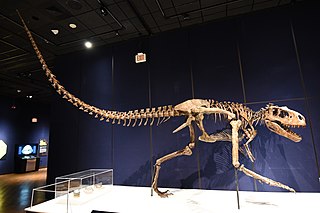
Albertosaurus is a genus of large tyrannosaurid theropod dinosaur that lived in northwestern North America during the early to middle Maastrichtian age of the Late Cretaceous period, about 71 million years ago. The type species, A. sarcophagus, was apparently restricted in range to the modern-day Canadian province of Alberta, after which the genus is named, although an indeterminate species has been discovered in the Corral de Enmedio and Packard Formations of Mexico. Scientists disagree on the content of the genus and some recognize Gorgosaurus libratus as a second species.

Tyrannosauridae is a family of coelurosaurian theropod dinosaurs that comprises two subfamilies containing up to thirteen genera, including the eponymous Tyrannosaurus. The exact number of genera is controversial, with some experts recognizing as few as three. All of these animals lived near the end of the Cretaceous Period and their fossils have been found only in North America and Asia.
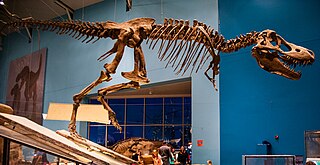
Tarbosaurus is a genus of tyrannosaurine theropod dinosaur that lived in Asia about 82 - 68 million years ago, during the Maastrichtian age at the end of the Late Cretaceous period, considered to contain a single known species: Tarbosaurus bataar. Fossils have been recovered from the Nemegt and Djadochta Formations of Mongolia, with more fragmentary remains found further afield in the Subashi Formation of China and the Jingangkou Formation of South Korea, along the South Korean Peninsula.

Gorgosaurus is a genus of tyrannosaurid theropod dinosaur that lived in western North America during the Late Cretaceous Period (Campanian), between about 76.6 and 75.1 million years ago. Fossil remains have been found in the Canadian province of Alberta and the U.S. state of Montana. Paleontologists recognize only the type species, G. libratus, although other species have been erroneously referred to the genus.

Deinocheirus is a genus of large ornithomimosaur that lived during the Late Cretaceous around 70 million years ago. In 1965, a pair of large arms, shoulder girdles, and a few other bones of a new dinosaur were first discovered in the Nemegt Formation of Mongolia. In 1970, this specimen became the holotype of the only species within the genus, Deinocheirus mirificus; the genus name is Greek for "horrible hand". No further remains were discovered for almost fifty years, and its nature remained a mystery. Two more complete specimens were described in 2014, which shed light on many aspects of the animal. Parts of these new specimens had been looted from Mongolia some years before, but were repatriated in 2014.

Alectrosaurus is a genus of tyrannosauroid theropod dinosaur that lived in Asia during the Late Cretaceous period, about some 96 million years ago in what is now the Iren Dabasu Formation.
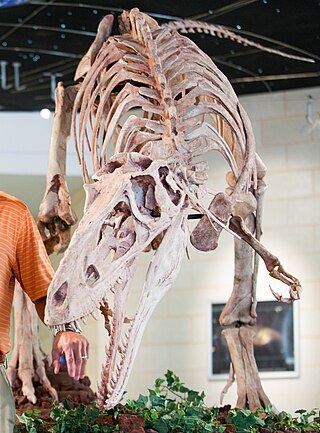
Alioramus is a genus of tyrannosaurid theropod dinosaurs from the Late Cretaceous period of Asia. It currently contains two species. The type species, A. remotus is known from a partial skull and three foot bones recovered from the Mongolian Nemegt Formation, which was deposited in a humid floodplain about 70 million years ago. These remains were named and described by Soviet paleontologist Sergei Kurzanov in 1976. A second species, A. altai, known from a much more complete skeleton also from the Nemegt Formation, was named and described by Stephen L. Brusatte and colleagues in 2009. Its relationships to other tyrannosaurid genera were at first unclear, with some evidence supporting a hypothesis that Alioramus was closely related to the contemporary species Tarbosaurus bataar. However, the discovery of Qianzhousaurus indicates that it belongs to a distinct branch of tyrannosaurs, namely the tribe Alioramini.

Opisthocoelicaudia is a genus of sauropod dinosaur of the Late Cretaceous Period discovered in the Gobi Desert of Mongolia. The type species is Opisthocoelicaudia skarzynskii. A well-preserved skeleton lacking only the head and neck was unearthed in 1965 by Polish and Mongolian scientists, making Opisthocoelicaudia one of the best known sauropods from the Late Cretaceous. Tooth marks on this skeleton indicate that large carnivorous dinosaurs had fed on the carcass and possibly had carried away the now-missing parts. To date, only two additional, much less complete specimens are known, including part of a shoulder and a fragmentary tail. A relatively small sauropod, Opisthocoelicaudia measured about 11.4–13 m (37–43 ft) in length. Like other sauropods, it would have been characterised by a small head sitting on a very long neck and a barrel shaped trunk carried by four column-like legs. The name Opisthocoelicaudia means "posterior cavity tail", alluding to the unusual, opisthocoel condition of the anterior tail vertebrae that were concave on their posterior sides. This and other skeletal features lead researchers to propose that Opisthocoelicaudia was able to rear on its hindlegs.

Tyrannosauroidea is a superfamily of coelurosaurian theropod dinosaurs that includes the family Tyrannosauridae as well as more basal relatives. Tyrannosauroids lived on the Laurasian supercontinent beginning in the Jurassic Period. By the end of the Cretaceous Period, tyrannosauroids were the dominant large predators in the Northern Hemisphere, culminating in the gigantic Tyrannosaurus. Fossils of tyrannosauroids have been recovered on what are now the continents of North America, Europe and Asia, with fragmentary remains possibly attributable to tyrannosaurs also known from South America and Australia.

Bagaraatan is a genus of theropod dinosaur from the Late Cretaceous period. Its fossils were found in the Nemegt Formation of Mongolia. Bagaraatan may have been around 3 to 4 metres in length.

The Nemegt Formation is a geological formation in the Gobi Desert of Mongolia, dating to the Late Cretaceous. The formation consists of river channel sediments and contains fossils of fish, turtles, crocodilians, and a diverse fauna of dinosaurs, including birds.

Tyrannosaurinae is one of the two extinct subfamilies of Tyrannosauridae, a family of coelurosaurian theropods that consists of at least three tribes and several genera. All fossils of these genera have been found in the Late Cretaceous deposits of western North America and east Asia. Compared to the related subfamily Albertosaurinae, tyrannosaurines overall are more robust and larger though the alioramins were gracile by comparison. This subfamily also includes the oldest known tyrannosaurid genus Lythronax as well as the youngest and most famous member of the group, Tyrannosaurus rex. There were at least 30 different species of tyrannosaurines.

Bistahieversor, also known as the "Bisti Beast", is a genus of basal eutyrannosaurian theropod dinosaur. The genus contains only a single known species, B. sealeyi, described in 2010, from the Late Cretaceous of New Mexico. The holotype and a juvenile were found in the Hunter Wash Member of the Kirtland Formation, while other specimens came from the underlying Fossil Forest member of the Fruitland Formation. This dates Bistahieversor approximately 75.5 to 74.5 million years ago during the Campanian age, found in sediments spanning a million years.
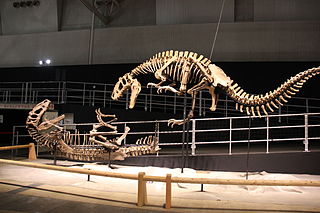
Yutyrannus is a genus of proceratosaurid tyrannosauroid dinosaur which contains a single known species, Yutyrannus huali. This species lived during the early Cretaceous period in what is now northeastern China. Three fossils of Yutyrannus huali —all found in the rock beds of Liaoning Province— are currently the largest-known carnivorous dinosaur specimens that preserve direct evidence of feathers.
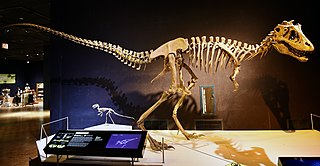
Lythronax is a genus of tyrannosaurid dinosaur that lived in North America around 81.9-81.5 million years ago during the Late Cretaceous period. The only known specimen was discovered in Utah in the Wahweap Formation of the Grand Staircase–Escalante National Monument in 2009, and it consists of a partial skull and skeleton. In 2013, it became the basis of the new genus and species Lythronax argestes; the generic name Lythronax means "gore king", and the specific name argestes originates from the Greek poet Homer's name for the wind from the southwest, in reference to the specimen's geographic provenance in North America.

Suskityrannus is a genus of small tyrannosauroid theropod from the Late Cretaceous in southern Laramidia. It contains a single species, Suskityrannus hazelae, and the type specimen was found in the Turonian-age Moreno Hill Formation of the Zuni Basin in western New Mexico.

This timeline of tyrannosaur research is a chronological listing of events in the history of paleontology focused on the tyrannosaurs, a group of predatory theropod dinosaurs that began as small, long-armed bird-like creatures with elaborate cranial ornamentation but achieved apex predator status during the Late Cretaceous as their arms shrank and body size expanded. Although formally trained scientists did not begin to study tyrannosaur fossils until the mid-19th century, these remains may have been discovered by Native Americans and interpreted through a mythological lens. The Montana Crow tradition about thunder birds with two claws on their feet may have been inspired by isolated tyrannosaurid forelimbs found locally. Other legends possibly inspired by tyrannosaur remains include Cheyenne stories about a mythical creature called the Ahke, and Delaware stories about smoking the bones of ancient monsters to have wishes granted.

Timurlengia is an extinct genus of tyrannosauroid theropod dinosaur found in Uzbekistan, in the Bissekty Formation in the Kyzylkum Desert, hailing from the Turonian age of the early Late Cretaceous. The type species is Timurlengia euotica.

Oksoko is a genus of oviraptorid dinosaur from the Late Cretaceous of Asia, that lived in what is now the Nemegt Formation in Mongolia. It includes the type species Oksoko avarsan.
Xixiaichthys is an extinct genus of osteoglossiform fish that lived in China during the Early Cretaceous and was found in the Madongshan Formation and also the Xinminbao Group. The type species is Xixiaichthys tongxiensis and is based on the holotype, a complete skeleton, and several other specimens of varying completeness.






































